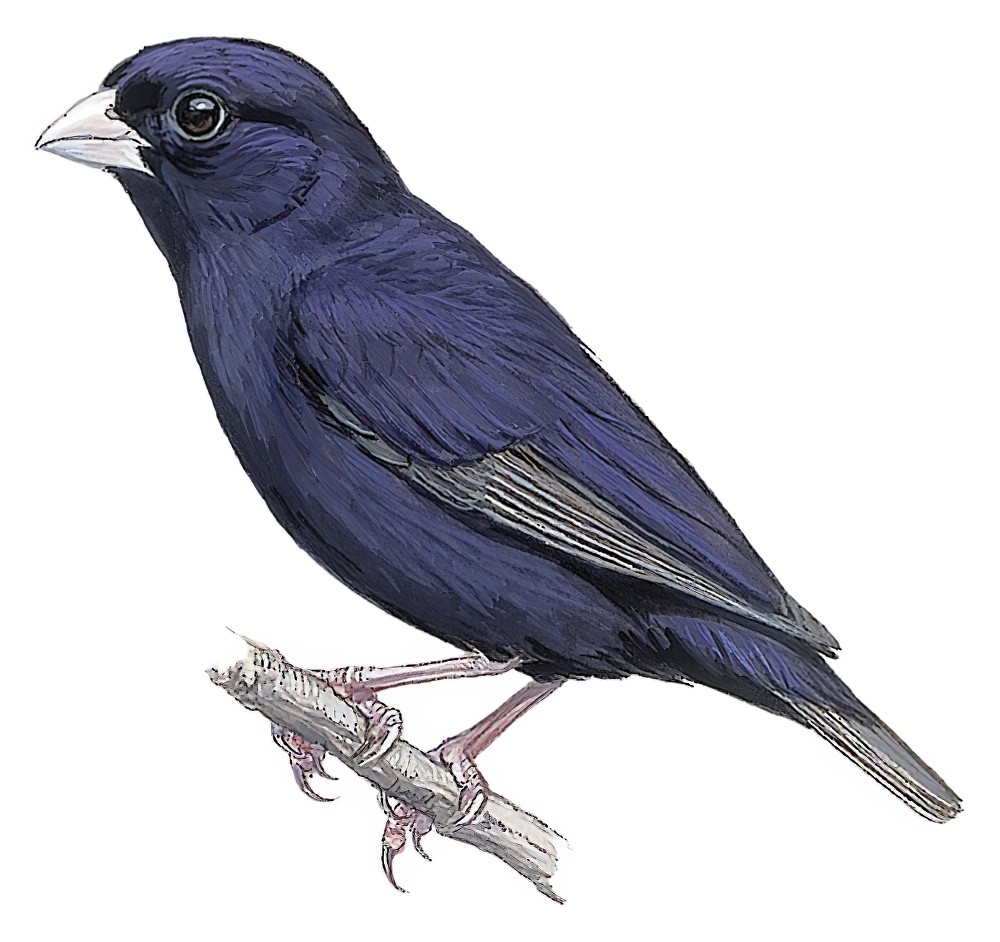Wilson’s Indigobird / Vidua wilsoni

Wilson's Indigobird
SCI Name:
Protonym: Hypochaera wilsoni Novit.Zool. 8 p.342
Taxonomy: Passeriformes / Viduidae / Vidua
Taxonomy Code: pawind1
Type Locality: Yelwa, in Borgu, middle Niger.
Author: Hartert, E
Publish Year: 1901
IUCN Status: Least Concern
DEFINITIONS
VIDUA
(Viduidae; † Pin-tailed Whydah V. macroura) L. vidua widow < viduus bereaved, widowed (see vidua); "LES VEUVES. (VIDUA. Cuv.) Sont des oiseaux d'Afrique et des Indes, à bec de linotte, quelquefois un peu plus renflé à sa base, qui se distinguent parce que quelques unes des couvertures supérieures de leur queue sont excessivement allongées dans les mâles (1). ... (1) On ne sait pourquoi Linnæus et Gmelin les ont associés aux bruans, sous les noms de emberiza regia (enl. 8, 1) — Emb. serena (ib. 2.) — Emb. paradisea (enl. 194.) — Emb. panayensis (enl. 647.) — Emb. longicauda (enl. 635.) Si on ne laisse pas les veuves avec les linottes, on ne peut les placer qu'avec les gros becs. N. B. L'emb. principalis (Edw. 270) et l'emb. vidua (Aldrow. Ornit. II, 565) me paraissent le même oiseau en différens états de plumage. L'emb. psittacea, Seb. I, pl. 66, fig. 5, n'est pas bien authentique. L'angolensis, Salern. Orn. 277; la veuve chrysoptère, Vieill. Ois. ch. pl. 41, et le lox. macroura, enl. 183, 1, qui n'en diffère peut-être pas, ne sont point des veuves, mais des gros becs ordinaires." (Cuvier 1817); "Vidua Cuvier, 1817, Règne Animal, 1, p. 388. Type, by tautonymy, Emberiza vidua Linnaeus = Fringilla macroura Pallas." (Traylor in Peters, 1968, XIV, p. 394).
Synon. Hypochera, Linura, Steganura, Tetraenura, Videstrelda, Widha.
• (Viduidae; syn. Vidua † Long-tailed Paradise Whydah V. paradisaea) "Vidua, Cuvier. (fig. 246.) Bill short. Wings lengthened; the second, third, and two following quills longest, and of equal length. Tail boat-shaped: males with the two middle feathers excessively elongated, generally broad and convex. V. rufitorques. W. Af. i. 174.(c) erythrorhynchus. Ib. (b) chrysonotus. W. Af. i. 174.(d) paradisea. Ib. pl. 11." (Swainson 1837); "Vidua "Cuvier" Swainson, 1837, Nat. Hist. Classification Birds, II, p. 278 (not of Cuvier, 1817). Type, by subsequent designation (G. Gray, 1855, Cat. Genera Subgenera Birds Brit. Mus., p. 71), Emberiza paradisaea Linnaeus, 1758." (JAJ 2021).
vidua
L. vidua widow < viduus bereaved, widowed (e.g. in mourning, black, veiled).
● ex “Aguimp” or “Lavandière Pie” of Levaillant 1805, pl. 178 (subsp. Motacilla aguimp).
● ex “Petite Veuve” and “Grande Veuve” of Brisson 1760; “is called la Veuve, or Widow Bird, from the colour ... Edwards gives another reason for the name - being a corruption of Whidah, a fort in Africa, in the neighbourhood of which they are common. Whidah Bird, and Widow Bird, are sounds very similar” (Latham 1783). Whydah or Whidah (now Ouidha, Benin), received its European name by a corruption of São João Baptista de Ajudá, a nearby Portuguese fort (syn. Vidua macroura).
● "Unfortunately Mons. Robert sent only one female of this distinct species. Of the allied H. griseiventris also the male is as yet unknown" (Hellmayr 1905) (Willisornis).
wilsoni
• Wilson's Inlet, southern Western Australia (syn. Acanthorhynchus superciliosus, syn. Calidris ferruginea).
• Lt.-Commander Roy Buchanan Wilson (1890-1979) Royal Navy, collector (Paul Scofield in litt.) (syn. Bradypterus barratti godfreyi, subsp. Crithagra sulphurata, syn. Erythropygia quadrivirgata).
• Dr Thomas Bellerby Wilson (1807-1865) US naturalist, patron of Academy of Natural Sciences, Philadelphia (Callaeas (ex “Glaucopis nova species” of Wilson MS), Coeligena).
• Dr Edward Adrian Wilson (1872-1912) English surgeon, zoologist, artist, Antarctic explorer with Scott 1901-1904, 1910-1912 (syn. Catharacta maccormicki, syn. Fregata ariel trinitatis, syn. Macronectes giganteus, syn. Pterodroma arminjoniana).
• Scott Burchard Wilson (1865-1923) English ornithologist, collector (subsp. Chlorodrepanis virens, Hemignathus, ‡syn. Zapornia sandwichensis).
• Alexander Wilson (1766-1813) Scottish/US pioneer naturalist, father of American ornithology (syn. Charadrius wilsonia, syn. Fulica americana, syn. Gallinago delicata, syn. Melanitta americana, syn. Oceanites oceanicus, syn. Pluvialis squatarola, syn. Steganopus tricolor, syn. Sterna hirundo) (see wilsonii).
• Ernest Henry Wilson (1876-1930) English botanist, plant collector in China 1899-1910 and Japan 1911-1916 (syn. Ithaginis cruentus).
• Francis Erasmus Wilson (1888-1960) Australian analytical chemist, entomologist, ornithologist, collector, RAOU Secretary 1911-1912 (syn. Manorina melanotis, syn. Poodytes gramineus goulburni).
• "The species name is derived from the family name Wilson, after the owners of Frome Downs Station, [South Australia] who have generously provided access and hospitality to collectors of fossil material from their property for many years." (Baird & Vickers-Rich 1998) (OD per Fred Ruhe). Bill, Laura, Alec and Debbie Wilson sold the property in 2010 (‡Paloelodus).
• Maj. Robert Adams Wilson (1876-1964) New Zealand Army, farmer, hunter, ornithologist (subsp. Poodytes punctatus).
• Capt. Malcolm Wilson (1869-1900) British Army in Ashanti 1900 (Vidua).
UPPERCASE: current genus
Uppercase first letter: generic synonym
● and ● See: generic homonyms
lowercase: species and subspecies
●: early names, variants, mispellings
‡: extinct
†: type species
Gr.: ancient Greek
L.: Latin
<: derived from
syn: synonym of
/: separates historical and modern geographic names
ex: based on
TL: type locality
OD: original diagnosis (genus) or original description (species)












